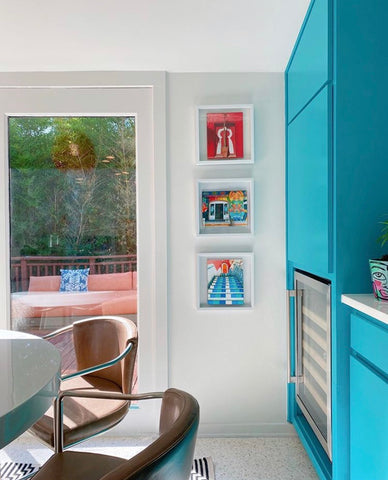We've all seen them in magazines or HGTV and social media - that beautifully curated, seemingly randomly placed but somehow perfectly balanced gallery wall. Gallery walls are a great way to feature a collection of art in a personal way with a lot of graphic impact.
But if you've ever sat down to create one, it can be overwhelming to know where to begin. I've got some inspiration photos, considerations and tips to help break it down into more manageable steps.
THEME
First, we need to pick something that's going to unite all the work. This could be a common color scheme, subject matter or frame selection. Whatever it is, it will help make the collection feel like, well, a collection. Here are some examples:
COLOR: This first photo (credit: West Elm) picks up on the 2 main colors of the room: the warm chestnut brown of the couch and the mermaid blue wall. Even though the art is all different sizes and housed in different frames, the common color palette brings cohesiveness to the room.
In this second example (credit: www.littlehouseoffour.com), the uniform pastel palette and ample white space unites the collection.
The opposite of color - black and white is another way to create a themed collection as seen here: (credit: sfgirlbybay.com)
SUBJECT MATTER: Another way to tie together artworks is through a common subject matter. This first photo (credit: @chairishco) is an excellent example of works by different artists whose portraiture (as well as unframed art) creates an aesthetically pleasing collection.
This next example, which hangs in a bedroom, (credit: @blessedlittlebungalow) does a good job combining text-based and line-based art with more traditional art for a theme of "love":
Other ideas are botanicals, abstracts, children's artwork, landscapes, animals, graphic/high contrast pieces, geometric, metallics... it can be anything - have fun with it!
FRAMES: Even though this children's art collection features a variety of sizes and styles, the identical acrylic frames make them feel like they are in the same family. (Photo and frames from: @wexelart)
And the frames don't have to be literally identical either. Here is another example (courtesy of PopSugar) which shows how a shared gold color and glam vibe is enough to provide a frame theme:
If you have artwork that needs to be framed, simplyframed.com and framebridge offer options to mail in your art and they do all the legwork, not to mention they have a huge frame selection. If you are shopping for framed artwork from moi, I'm proud to offer framing collaborations through Perigold, Saatchi Art and Wexel Art - each offering a separate line of my prints with a variety of framing options.
LAYOUT: This is probably the most intimidating part. It's going to be different for each wall, depending on the orientation, the sizes of your pieces and the limitations of the wall/obstructing furniture itself. There are two basic ways to go here - symmetrical/grid or asymmetrical/haphazard, so knowing which look you are going for will automatically narrow your options. TIP: Whichever you choose, I'd recommend laying it out on the floor first and taking an overhead photo with your phone. Reason being, viewing on your phone vs. in real life can give you more of a bird's eye perspective that can help you identify any imbalances - spatially, or visually.
If you like the look of a grid but have artwork of varying orientation, squares could solve the problem. This small gallery wall features both portrait and landscape photography, all housed in identical Instagram-inspired square frames: (credit: Shauna Glenn)
If you're going the asymmetrical route and feel like you need some structure to get started, here are some great resources for layout options, whether you're hanging on a feature wall (credit: littlegoldpixel.com) or going down a stairwell (credit: grillo-designs.com):
HANGING: This is probably the most intimidating part. See this Better Homes & Gardens quickie video which shows you how to use craft paper to mark not only your artwork dimensions, but where nail placement should go on the wall.
Another alternative is to hanging pictures on one or multiple picture ledges - this gives you tons of flexibility to arrange, rearrange and easily switch out artwork at a moment's notice (credit: Real Simple). Just make sure it has a small lip so that artwork won't slide off.
Lastly, if you don't want to mess up your walls, there's always 3M hooks to save the day!
I hope these tips bring you some ideas and encouragement to start your own gallery wall - you can do it! I'd love to see how they turn out - email me at hello@juliepelaezstudios.com or tag me on Instagram @juliepelaezstudios ! And if you're still searching for pieces for your collection, happy hunting! I know an abstract artist that has some really great pieces if that's what you're going for...
; )
Cheers,
Julie









